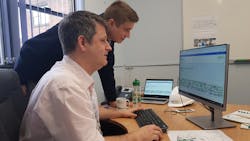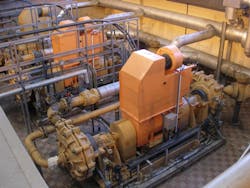Digital tool helps utilities overcome sludge pumping challenges
BEDFORD UK, JAN 22, 2020 -- Sophisticated software developed by BHR Group and launched this month is already helping water utilities analyze their sludge pumping systems and reduce costs.
SLOT 2.0, which is underpinned by BHR’s world-leading sludge rheology database, can calculate sludge flow properties and behaviors, frictional pipe pressure losses and system curves. The software can also identify the most effective pumps to use on a given system – selecting the optimal size, type, quantity and configuration, right down to the manufacturer.
Legislative changes and restrictions around sludge disposal to land has changed the nature of the sludge being processed by wastewater treatment plants – with sludges becoming ever thicker and the volumes growing at most sites. Novel sludge types are also emerging from new processes, such as thermal hydrolysis, and their rheological profile cannot be predicted using existing data.
To meet these multiple challenges, SLOT 2.0 – short for System LOsses Tool - has been developed to help utilities know their sludge better. Users can predict sludge rheology based on type, temperature and the proportion of dry solids.
They can quickly compare results for different rheological properties and possible combinations of pipework, pumps and components; plotting system curves against pump curves to determine optimum pump-operating points.
Mick Dawson, consultancy director, BHR Group said, “Water companies are being challenged to optimize their existing facilities in the next asset management period, AMP7, which starts on 1 April 2020. Whether users are moving sludge within a treatment facility or between sites, SLOT 2.0 can help calculate how much energy is required, which pipes and pumps offer the greatest efficiency and whether a system has the capacity and resilience to manage changing sludge properties.”
He added, “Assets for sludge transport and treatment are expensive to buy and operate, especially with the capital cost of pumps and the energy they consume. In addition, they are often expected to operate at a wide range of flow rates and conditions.
“If the system and its components are wrongly sized it could significantly impact the purchasing and operating cost of the process system - increasing total investment for no discernible return or failing to deliver the flow required. SLOT 2.0 gives the user and utility multiple benefits, but at its core is the reduced risk of asset failure.”
Beta testing of the software has been undertaken by a combination of water utilities and contractors including NMCN, Sweco and DPS.
Dawson concludes, “The development of SLOT 2.0 has been a major investment of time and resource for the team here at BHR Group. Feedback from our beta testers has been very encouraging and we believe this technology will raise the game on sludge processing across the water industry. It’s great to see people using it and starting to capture the benefit.”
The official launch of SLOT 2.0 will take place at the WWT Wastewater Conference & Exhibition in Birmingham on 28 January 2020. Potential users of SLOT 2.0 are also invited to join BHR Group at British Water’s headquarters in London on 25 February 2020 to try out the tool and learn more about its capability. Learn more at www.bhrgroup.com.

